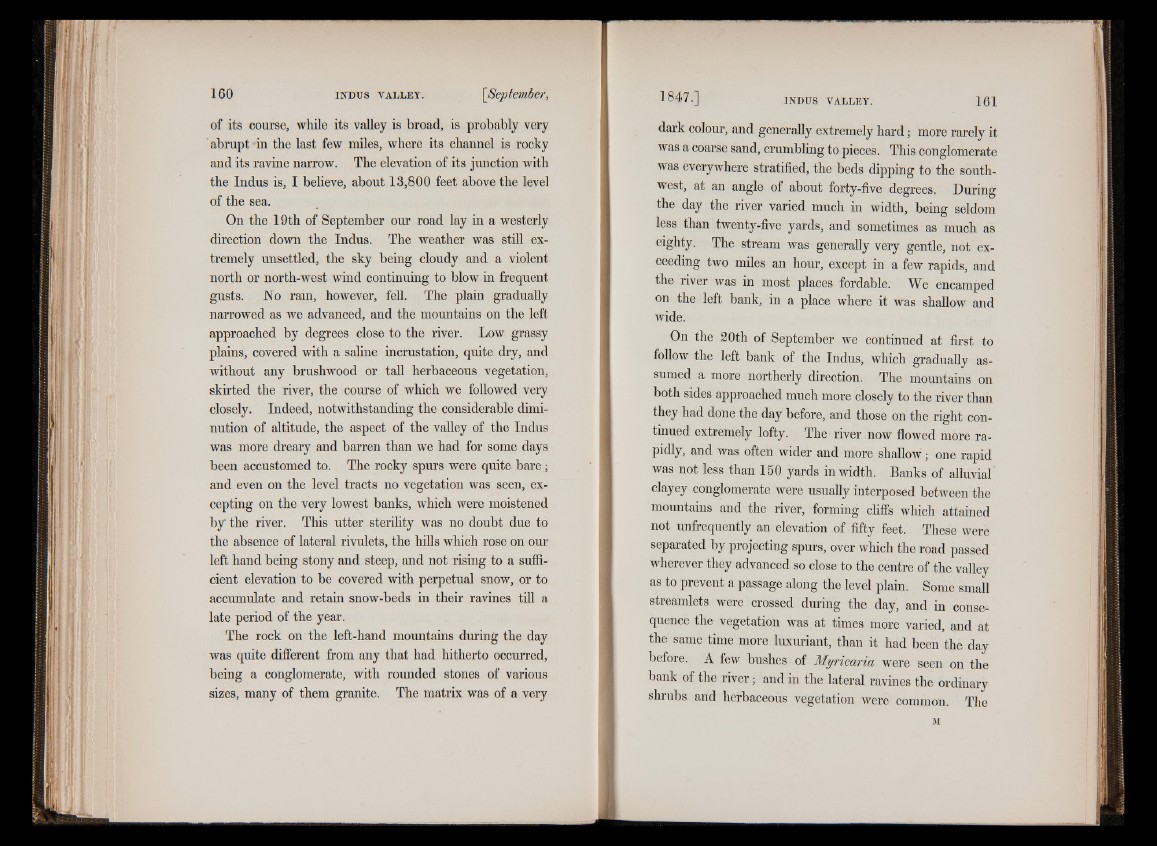
of its course, while its valley is broad, is probably very
abrupt in the last few miles, where its channel is rocky
and its ravine narrow. The elevation of its junction with
the Indus is, I believe, about 13,800 feet above the level
of the sea.
On the 19th of September our road lay in a westerly
direction down the Indus. The weather was still extremely
unsettled, the sky being cloudy and a violent
north or north-west wind continuing to blow in frequent
gusts. No rain, however, fell. The plain gradually
narrowed as we advanced, and the mountains on the left
approached by degrees close to the river. Low grassy
plains, covered with a saline incrustation, quite dry, and
without any brushwood or tall herbaceous vegetation,
skirted the river, the course of which we followed very
closely. Indeed, notwithstanding the considerable diminution
of altitude, the aspect of the valley of the Indus
was more dreary and barren than we had for some days
been accustomed to. The rocky spurs were quite bare;
and even on the level tracts no vegetation was seen, excepting
on the very lowest banks, which were moistened
by* the river. This utter sterility was no doubt due to
the absence of lateral rivulets, the hills which rose on our
left hand being stony and steep, and not rising to a sufficient
elevation to be covered with perpetual snow, or to
accumulate and retain snow-beds in their ravines till a
late period of the year.
The rock on the left-hand mountains during the day
was quite different from any that had hitherto occurred,
being a conglomerate, with rounded stones of various
sizes, many of them granite. The matrix was of a very
dark colour, and generally extremely hard; more rarely it
was a coarse sand, crumbling to pieces. This conglomerate
was everywhere stratified, the beds dipping to the southwest,
at an angle of about forty-five degrees. During
the day the river varied much in width, being seldom
less than twenty-five yards, and sometimes as much as
eighty. The stream was generally very gentle, not exceeding
two miles an hour, except in a few rapids, and
the river was in most places fordable. We encamped
on the left bank, in a place where it was shallow and
wide.
On the 20th of September we continued at first to
follow the left bank of the Indus, which gradually assumed
a more northerly direction. The mountains on
both sides approached much more closely to the river than
they had done the day before, and those on the right continued
extremely lofty. The river now flowed more rapidly,
and was often wider and more shallow; one rapid
was not less than 150 yards in width. Banks of alluvial
clayey conglomerate were usually interposed between the
mountains and the river, forming cliffs which attained
not unfrequently an elevation of fifty feet. These were
separated by projecting spurs, over which the road passed
wherever they advanced so close to the centre of the valley
as to prevent a passage along the level plain. Some small
streamlets were crossed during the day, and in consequence
the vegetation was at times more varied, and at
the same time more luxuriant, than it had been the day
before. A few bushes of Myricaria were seen on the
bank of the river; and in the lateral ravines the ordinary
shrubs and herbaceous vegetation were common. The
M